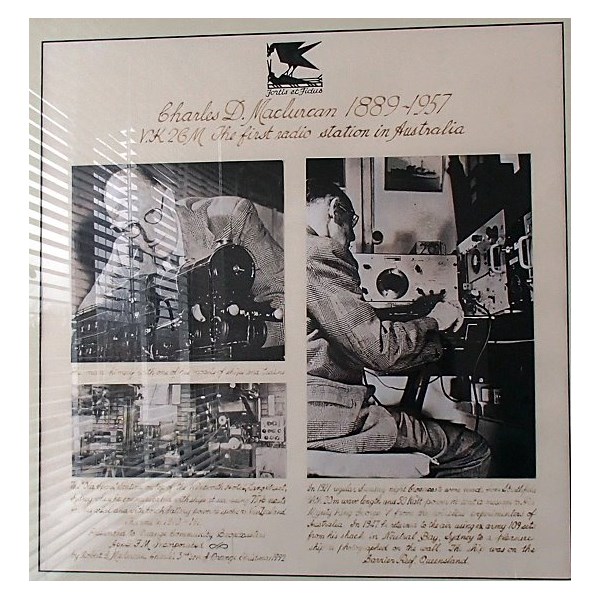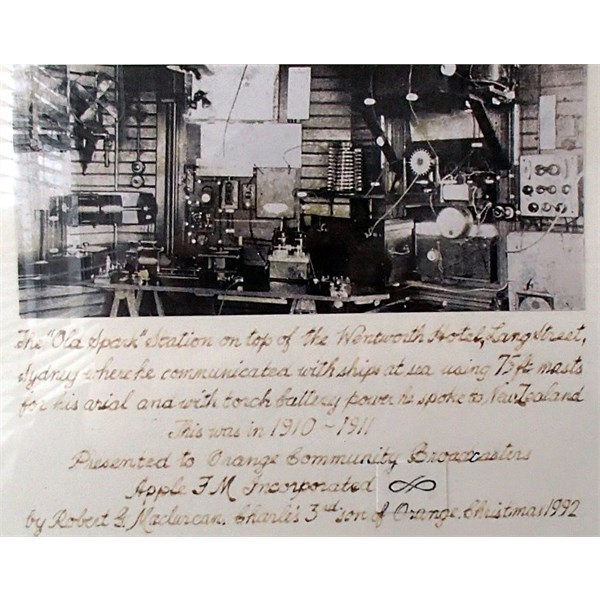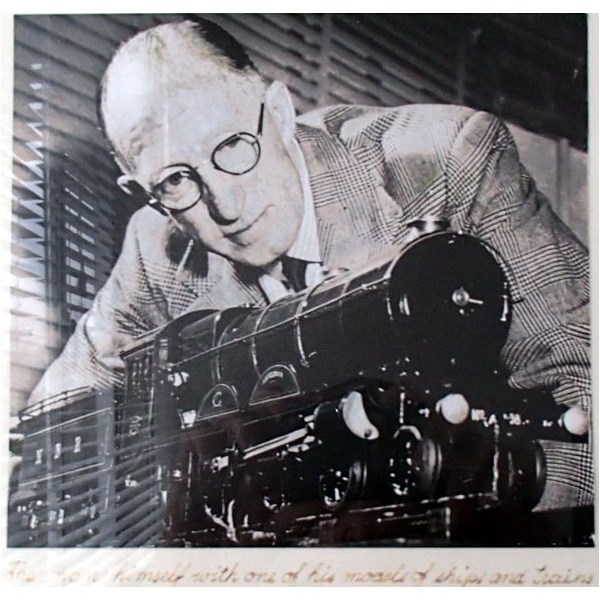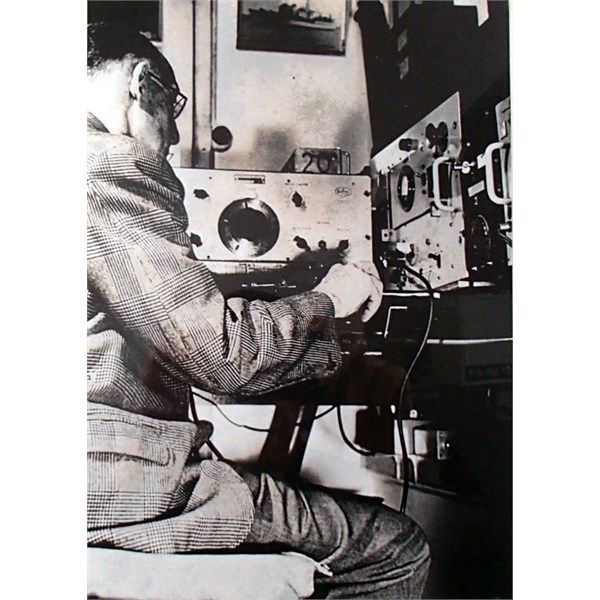Australian Amateur Radio Call Signs may seem a little baffling but looking back at the way in which our call signs have evolved shows that it has been much more confusing in the past.
There were wireless experimenters in most states of Australia from about 1897, very soon after Marconi's demonstrations in London. Engineers from the Post & Telegraph Dept., University researchers and a few individuals duplicated Marconi's wireless system in the period 1900-1904, with varying degrees of success. There were no call signs assigned at that time, and operators simply used their station location or their names or initials as identifiers. Experimenters were supposed to obtain permission from the "Royal Navy on Australian Station", ie before the formation of the Australian Navy, but most didn't bother and the Navy had no wireless to hear them anyway, although occasionally visiting Navy ships were equipped with wireless equipment.
By 1904 the Australian Navy (actually the Royal Navy on Australian Station) did have several ships equipped with wireless and used the ship's names or initials as identification. For example the RNS "St George" was just "SG". The Navy was keen to restrict wireless to military purposes only, but wireless manufacturers saw Australia as a lucrative commercial market and demanded access. The Australian Government therefore enacted The Wireless Telegraphy Act of 1905 to place control of wireless under the PMG's Department. The W.T. Act did provide for private experimenters but because of the high fees (£3) and severe penalties (£500 fine or 5 years imprisonment for offences) very few licences were issued.
A Mr H.G. Robinson obtained what was probably the first experimental licence issued, in November 1905 for "experiments in halls for lecture purposes", while the Marconi Co. (NZ) obtained a licence in 1906 for trials of communication between Victoria and Tasmania. Also in 1906 E.F.G. Jolley of
Maryborough, Victoria, had stations in two houses about a mile apart. These licences all expired after 1 year. By 1908 the only experimental licence current in Australia was held by the engineer for the Victorian PMG, H.W. Jenvey, who built two stations early in 1908, one at St. Kilda and another 65
miles away at Queenscliff,
Melbourne. In 1909 there were only two licences on issue, held by Henry Sutton at 290-292
Bourke St.
Melbourne, with apparatus capable of a 250 mile range, and C.P. Bartholomew at Mosman, NSW, with a range of 1/2 mile. Henry was issued his 'provisional licence' on the 7 October 1909 by Sir
John Quick, permitting a maximum signalling range of 250
miles.
In 1910 the Australasian Wireless Company was licensed with the call sign ATY, and then it obtained AAA when a new station was erected at the 6th floor of the Hotel Australia,
Sydney in 1911, with 2 masts on the roof. This was the first commercial license in Australia. This was in response to the Orient Steamship Company installing wireless telegraphy stations on each of its steamers to execute the new English mail contract issued early February 1910.
The PMG discouraged experimenters but after representations by the newly formed Wireless Institute of Australia in April 1910 it adopted a more liberal attitude to licensing so that by August 1911 there was a total of 27 authorised "experimental" stations, 22 located in
Sydney, 3 in
Melbourne, 1 in SA and 1 on King Island off Tasmania.
Beginning mid-1910 the PMG Dept. issued the experimental stations with 2 letter call signs prefixed by "X" for experimental, with no distinction between states, or between private and commercial operators. For instance XAA was J.Y.
Nelson (the Senior Electrical Engineer of the
Sydney PMG Dept. and also the local radio inspector), F. Leverrier, a leading
Sydney experimenter, was XEN, N.S. Gilmour, of St. Kilda, was XNG, Father A. Shaw of the Maritime Wireless Company had XPO and so on. By the way, the experimental licence consisted of 6 foolscap pages of regulations and restrictions and sketches of the equipment. None of the equipment could be altered without approval of the local PMG authority, who could make inspections at any time. Commercial wireless telegraphy operations were retained as a monopoly of the PMG
.
Experimental Licences current at August 1911.
LICENCE NO. CALL SIGN NAME LOCATION
1 XBM C.P. Bartholomew Mosman,
Sydney / 2 Henry Sutton Malvern,
Melbourne
3 XJQ W.T. Appleton Malvern,
Melbourne / 4a XJP J.H.A. Pike Arncliffe,
Sydney
4b A.V. Robb Arncliffe,
Sydney / 5 XEN F. Leverrier Waverley,
Sydney
6 W.H. Hannam Darling Point,
Sydney / 7 XPO Rev. A. Shaw Randwick,
Sydney
8 G.C.
Hamilton Woollahra,
Sydney / 9 Royal Yacht Squadron
Sydney
10 XDM Maclurcan & Lane Hotel
Wentworth,
Sydney 
Sydney Morning Herald, May 31 1923
11 E. Reeve Rozelle,
Sydney / 12 A. Mcardle Kilkenny and Enfield, S.A.
13 XAA J.Y.
Nelson PMG Dept. McMahons Point.,
Sydney / 14 H. Leverrier
Gordon,
Sydney
15 XCP M.C. Perry Randwick,
Sydney / 16 XAB A.S. Arnold Ashfield,
Sydney
17 A.H. King Marrickville,
Sydney / 18 F.H. Day C of E. Grammar School,
Sydney
19 J.S. Nolan Waverley,
Sydney / 20 XCA R.C. Alsop Randwick,
Sydney
21 H.A. Stowe Drummoyne,
Sydney / 22 A. Goodwin
Hamilton,
Melbourne
23 C.N. Allen Chatswood,
Sydney / 24 H.J.B. Foley Randwick,
Sydney
25 XPO Rev. A. Shaw King Island, Tasmania
(Maritime Wireless Co. of Australia)
26 AAA Australasian Wireless Ltd. Hotel Australia,
Sydney - previously
27 ATY Australasian Wireless Ltd. Underwood St.,
Sydney
There are indications that a number of experimenters of the time did not apply for licences, either through ignorance of the requirements or deliberately, hoping not to be caught.
Last Wednesday when I was in the Studio of FM 107.5
Orange to do my 1 hour on air I spotted the photo on the wall so took some photo's of it for today's SHP.

Photo at Radio Station FM107.5 Orange

The Old Spark Station

Charles D. Maclurcan and his model trains.

Charles D. Maclurcan on air
Text for the above photo.
In 1921 Regular Sunday night broadcasts were made from Strathfield with 20m wave length and 50 watt power , he sent a message to His Majesty King George V from the Wireless Experimenters of Australia. In 1947 he returned to the air using ex Army 109 sets from his
shack in Neutral Bay ,
Sydney to a pleasure Ship as photographed on the wall. The Ship was on the Barrier Reef , Queensland.
-----------------------------------------------------------------------------------------------
When the government wireless stations at
Sydney and Applecross (WA) commenced operations in 1912 they were allocated callsigns POS, for
Post Office Sydney, and POP for
Perth, (the other Australian stations as POA, POB, POH, POM, POP and POS) but following an international wireless convention which allocated prefixes on a world wide basis the PO was changed to a VI, hence VIS and VIP. The government established 22 coastal stations all with VI prefixes. In 1912 the callsign prefix letter V was a commemoration of the recent death of Queen Victoria and was used as a prefix in many Commonwealth countries from 1912. Australia was allocated the prefix group VH~VK, but these prefixes were not assigned to radio amateurs until 31 December 1928. At the same time, new regulations were introduced which banned the playing of gramophone records during the hours when broadcasting stations were operating.
Not many licensees had the chance to use the new calls before the declaration of World War 1 and all wireless experiments ceased in August 1914. Several people and organisations did obtain special permission to continue operations, such as the
Perth Wireless Club, as a listening post only, for suspected spies in W.A. and Ernest Fisk, Manager of AWA, who could both transmit and receive. The Government wireless stations continued in operation but in November 1916 the Navy again took control of all wireless, including the commercial and government stations.
After WW1 the Navy still controlled the airwaves and was reluctant to allow wireless experiments but following extended negotiations between the WIA and the Navy, Radio Commander Creswell agreed in June 1919 to issue Temporary Permits to experiment in Wireless telegraphy. These were for receiving only but permits to transmit and receive were issued to the WIA, a couple of Universities and one or two prominent experimenters. There were added restrictions to be observed if the licensee wished to use a valve (usually in a regenerative circuit which could perhaps cause interference to Navy wireless). At this time the Naval Director of Radio
Services instigated a new call sign system consisting simply of the sequential licence number, prefixed by the state initial. For instance R.H. Davies of
Melbourne obtained licence number 237 so his call sign was V.237 whilst the next applicant, A.B. Cummings in Queensland was call sign Q.238. By February 1920 more than 600 permits had been issued. In April 1920 the Government took charge and re-introduced regulations allowing experimental and instructional licences. An experimental licence cost £2/-/-.
In September 1920, the Government amended the Wireless Telegraphy regulations to remove all wartime restrictions and placed the control of wireless under the "Director of Radio Telegraphy, Prime Minister's Department, Melbourne". The Prime Minister was in discussion with AWA over a UK/Australia communications link and wanted to keep close control of wireless, and the PMG was reluctant to take back responsibility for commercial wireless anyway because it was a money losing situation. When the new Director took over from the Navy in early 1921 he changed back to the pre-war call system of X2AA etc. Some "transmitters", as they were called, requested specific call signs, so for example one leading transmitter, Charles D. Maclurcan, obtained X2CM.

In Memoriam. Charles D. Maclurcan
When new broadcast regulations finally became effective in August 1923 a new class of licence was issued, a "Broadcast Listener's Licence", costing 10/-.However, it was obvious that obtaining a receive only experimental licence for 20/-, with no restrictions on tuning, was cheaper than the broadcast listener's licence plus the station fee of £2/2/- to £4/4/-, and so somewhere around 1000 "listeners" applied for experimenter's licences. The broadcast stations soon complained that they were not receiving their expected fees so the PMG sent out letters to people who had receive only experimental licences, cancelling those licences and call signs and telling them to apply for a broadcast listener's licence. Many licences were in fact cancelled, but someone objected in early 1924 and the government found that as the licence was validly issued, it could not be cancelled, even though the licensee was not in all fairness a wireless "experimenter".
To solve that problem, as each licence came up for renewal after 12 months, the licensee had to demonstrate that he was actually competent to experiment with wireless and was not just a "listener". Previously, any exam or morse
test was at the discretion of the radio inspector and it appears very few previous applicants had to prove they knew anything about wireless. With the new approach, the number of experimental licences in the period 1924-1925 dropped significantly from the 1923 level and many names and call signs vanished. It was estimated in early 1925 that there were about 1200 experimental licensees in Australia, of which less than 90 were transmitters and the rest, even though they held call signs, should have been reclassified as Broadcast Listeners. Deleting all these listeners from the call sign lists left many gaps in the sequence up till the mid-'40s when growth in numbers finally made the 3 letter call sequence necessary.
This practice of issuing call signs to listeners with no real technical expertise raises a problem concerning claims by some old timers' to precedence in amateur activities. For instance Miss F. Violet Wallace (later Mrs. McKenzie), is regarded as the first Australian female amateur, but the records show that there were four ladies, all listeners only but with valid call signs, before Miss Wallace obtained her licence. She set up her own electrical contracting business in 1918, and apprenticed herself to it, in order to meet the requirements of the Diploma in Electrical Engineering at
Sydney Technical College and in 1922 she was the first Australian woman to take out an amateur radio operator's license. Through the 1920s and 1930s, her "Wireless Shop" in
Sydney's Royal Arcade was renowned amongst
Sydney radio experimenters and hobbyists. She founded The Wireless Weekly in 1922, established the Electrical Association for Women in 1934, and wrote the first "all-electric cookbook" in 1936.

Florence Violet McKenzie in 1940
Amateur Licences in Australia were withdrawn on 31 August 1939.
In 1975, a Novice licence was introduced using the callsign format VKnNXX. From 1980 those with both restricted and limited accreditations, the callsign format of VKnJXX and VKnKXX was used, and was later called the Intermediate licence.
The Novice Limited callsign was introduced later and used the VKnHXX format for novice stations without any CW privileges.
.